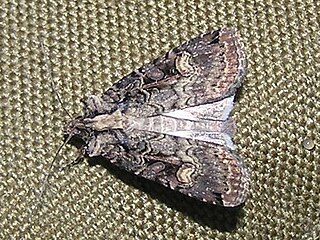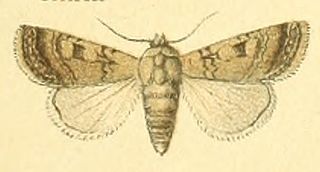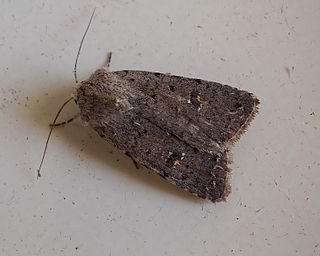
The Noctuidae, commonly known as owlet moths, cutworms or armyworms, are the most controversial family in the superfamily Noctuoidea because many of the clades are constantly changing, along with the other families of the Noctuoidea. It was considered the largest family in Lepidoptera for a long time, but after regrouping Lymantriinae, Catocalinae and Calpinae within the family Erebidae, the latter holds this title now. Currently, Noctuidae is the second largest family in Noctuoidea, with about 1,089 genera and 11,772 species. However, this classification is still contingent, as more changes continue to appear between Noctuidae and Erebidae.

Euxoa temera is a moth of the family Noctuidae. It is found in Central and Southern Europe, North Africa, the Caucasus, Armenia, Central Asia, Turkey, Iraq and Iran.

Epilecta linogrisea is a moth of the family Noctuidae. It is found in Central and Southern Europe, Algeria, Morocco, the Caucasus, Armenia, Turkey, North-Western Iran, Syria, Israel and Lebanon.

Chersotis multangula is a moth of the family Noctuidae. It is found in the mountainous areas of Central and Southern Europe, Morocco, Turkey, Armenia, Iran, Syria, Lebanon and the Caucasus.
Autophila limbata is a moth of the family Noctuidae first described by Otto Staudinger in 1871. It is found in southern France, southern Italy, the Iberian Peninsula, Greece, the Crimea, the Near East, Iran, Transcaucasia and Turkmenistan.
Hadena clara is a species of moth of the family Noctuidae. It is found in Morocco, southern Europe, Turkey, Armenia, Azerbaijan, the Caucasus region, Israel, Lebanon, Syria and Iran.
Hadena drenowskii is a species of moth of the family Noctuidae. It is found in the Balkans, Ukraine, Turkey, Armenia, Israel, the Caucasus region, Iran and Turkmenistan.

Mythimna sicula is a species of moth of the family Noctuidae. It is found from Morocco to Libya, central and southern Europe, Turkey, Israel, Iran and Turkmenistan.
Chersotis fimbriola is a moth of the family Noctuidae. It is found in number of isolated populations from Austria to Spain, Morocco, Turkey, Iraq, Iran and Turkmenistan.
Calocucullia celsiae is a moth of the family Noctuidae. The species was first described by Gottlieb August Wilhelm Herrich-Schäffer in 1850. It is found from the Balkans to Turkey, northern Iraq, Armenia, Iran, Israel, Jordan and Lebanon.
Euchalcia emichi is a moth of the family Noctuidae. It is widespread in Turkey, Armenia, Iran, Azerbaijan and Iraq. In the Levant it has been recorded from Syria, Lebanon and Israel.

Chazaria incarnata is a species of moth of the family Noctuidae. It is found on the Canary Islands and on the Iberian Peninsula, east to Italy, Serbia, Romania, Bulgaria, North Macedonia and Greece. Further east it is found to southern and eastern Russia in the north and Turkey, the Dead Sea region of Israel and Iran.
Heliothis philbyi is a species of moth of the family Noctuidae. It is found in the Middle East, including Saudi Arabia, Iran and Oman.

Heliothinae is a small subfamily of moths in the family Noctuidae. There are about 400 species described worldwide. They are found more commonly found in partially dry areas of subtropical habitats.

Opigena polygona is a moth of the family Noctuidae. It is found from the Netherlands, Sweden and Finland, through central and south-eastern Europe to central Asia, northern Iran, the Caucasus, Transcaucasia, Armenia, Turkey, Irkutsk, western and central China, Tibet, Nepal and northern India.

Euxoa hilaris is a moth of the family Noctuidae. It is found in Turkey, southern and eastern Russia, Bulgaria, Turkmenia, the Caucasus, Armenia, Lebanon, Iraq and Iran.

Chersotis larixia is a moth of the family Noctuidae. It is found in Spain, France, Switzerland, Italy and Sicily, Crete, Turkey, and east to Armenia, Azerbaijan, Syria, Iran, Lebanon, and Turkmenistan. In Europe, it is found in mountainous regions, like the Pyrenees, the Alps, and the Maritime Alps, up to heights of 2,000 meters.

The Erebidae are a family of moths in the superfamily Noctuoidea. The family is among the largest families of moths by species count and contains a wide variety of well-known macromoth groups. The family includes the underwings (Catocala); litter moths (Herminiinae); tiger, lichen, and wasp moths (Arctiinae); tussock moths (Lymantriinae), including the arctic woolly bear moth ; piercing moths ; micronoctuoid moths (Micronoctuini); snout moths (Hypeninae); and zales, though many of these common names can also refer to moths outside the Erebidae. Some of the erebid moths are called owlets.

Caradrina flavirena is a moth of the family Noctuidae. It was described by Achille Guenée in 1852. It is found in Morocco, Algeria, southern Europe, Turkey, Israel, Lebanon, Jordan, Syria, Armenia and Iran. The habitat consists of grasslands.

Caradrina selini is a moth of the family Noctuidae. It was described by Jean Baptiste Boisduval in 1840. It is found in most of Europe, North Africa and the Near East.












